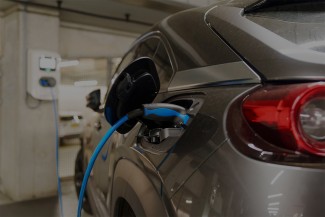Without at-home charging, residents of new developments geared toward lower-income families risk being left behind in the transition to electric vehicles. New research identifies strategies to expand equitable charging infrastructure in newly developed multifamily affordable housing.
Electric vehicle (EV) use is expected to rise rapidly in the coming years as prices continue to drop. However, we are not on track to have sufficient charging infrastructure at multifamily properties to meet future demand, including in lower-income areas.
Now, some innovative affordable housing developers have started including EV chargers or the EV-ready infrastructure to easily add them later. Their experiences can help inform others.
Read the Report A new ACEEE report identifies the obstacles to including EV charging infrastructure in new multifamily affordable housing developments. It outlines the strategies used by developers who have successfully integrated EV charging.
Including EV chargers during construction avoids costly retrofits later
Developers we interviewed who had installed EV charging found strong reasons to do so during construction and held the view that electric vehicles are inevitable.
These developers see installing chargers during construction as a practical way to future-proof their properties, helping them remain aligned with tenant expectations over time and avoiding the need for costly retrofits later. Given how tight budgets are for affordable housing developers, minimizing future expenses is not just a strategic choice but a critical factor in maintaining the development’s long-term financial viability.
Building codes can normalize EV readiness
Building codes that require new housing to include the electrical capacity and infrastructure necessary to support future EV charger installations can normalize EV readiness as a standard part of the development process, thereby removing the need to rely on developers to actively prioritize it among competing construction demands.
However, EV-ready codes in many states and cities currently include exemptions for affordable housing, undermining their ability to drive equitable charging access. Several developers we interviewed acknowledged that if they had wanted to avoid the installation requirement in their area, securing an exemption would have been easy. However, the developers who installed EV infrastructure reported that it was not burdensome to incorporate when appropriately planned from the outset.
Where EV infrastructure is not required, charger installation is likely to remain a lower priority than other construction considerations. Most developers will need some form of external motivation to invest the additional effort to incorporate charging infrastructure.
Funding and technical assistance help spur charging
Developers we spoke to often included EV infrastructure because it was necessary to qualify for state grants, green financing, or other funding sources. However, accessing that funding wasn’t always straightforward. The complexity of applying for and combining multiple funding sources can create administrative burdens, and developers often don’t see applying for charger-specific funding as worthwhile. For funding to be an effective motivator, it should be accessible, streamlined, and designed to be worth the time it takes to pursue.
External partnerships also emerged as a key catalyst for decision-making regarding installations. Collaborations with car-sharing programs, charging providers, or municipal agencies can significantly reduce both the financial and logistical challenges associated with installing and managing EV infrastructure. In many cases, partners assist with securing funding, managing charger operations, and easing the administrative burden, factors that developers were more likely to perceive as significant barriers than the physical installation itself.
Early technical coordination can avoid long-term setbacks
EV charging infrastructure introduces a relatively new suite of additional considerations that developers are only beginning to learn how to navigate. Critical considerations—such as electrical load requirements, charger specifications, operational management policies, and decisions about who will pay for electricity use—are often overlooked or addressed too late in the development process to allow for optimal charger setup. As one developer described their experience,
"That’s another area that’s been challenging for us, operationally—getting the technology in place and figuring out how to manage the software, the billing, and the setup. Like, can the general public use these? Is it only for our residents? What are the rates that we charge? All the companies have software that you can use to set all that up, but it's a new management piece for our organization."
Some of these knowledge gaps stem from poor or slow coordination with utilities. Developers often depend on utilities for information about electrical capacity and load requirements, and delays in receiving this information can create tangible risks to project timelines and budgets. Utilities should engage with developers early in the development process to ensure that technical details and logistics are addressed proactively.
Operational planning starts at installation
Operational decisions are closely intertwined with installation choices, but developers realized they had learned this later in the process than they should have. For example, deciding whether EV chargers will be publicly accessible or reserved for residents can influence the type of hardware selected, required software features, and how charging is powered and billed. Without early planning, developers risk installing infrastructure that doesn’t meet their future needs.
One developer described installing a dual-port charger with one port allocated for a car-sharing vehicle. But because they had not planned for how the second port would be used by residents—including pricing rates, billing systems, and access policies—it had not been turned on.
State energy offices can play a crucial role in helping developers navigate the complexities of EV charging and addressing the knowledge gaps that arise during installation, which can impact charger operations. By providing resources, hands-on assistance, and referrals to consultants and expert partners, state agencies can help developers consider operational aspects early on, thereby ensuring smoother long-term charger operation.
Keeping pace in the EV transition
As the shift to EVs continues, developers need to be better equipped to make decisions that serve both their residents and the long-term value of their properties. With the proper support, policies, and partnerships in place, we can ensure charging access grows alongside EV adoption, not just for some, but for everyone.



